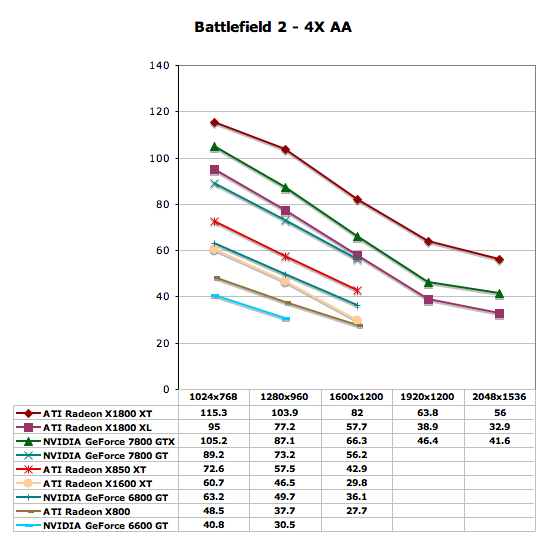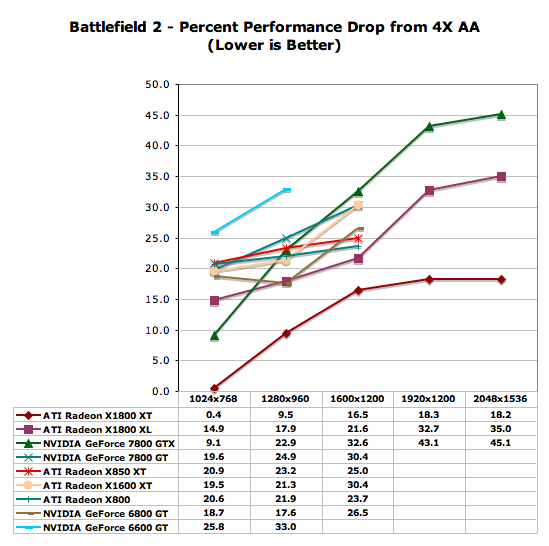ATI's X1000 Series: Extended Performance Testing
by Derek Wilson on October 7, 2005 10:15 AM EST- Posted in
- GPUs
Battlefield 2 Performance
The most requested game that we didn't include in our initial coverage is Battlefield 2. This highly popular game is quite important in comparing performance, as it does an excellent job of setting the standard for first-person shooter quality. The numbers that we attained came from running our custom BF2 demo on the highest quality settings. This means that anisotropic filtering was enabled both with and without AA (as Doom 3's high quality mode also enables AF).
Our "no AA" performance numbers show the X1800 XT performing on par with the 7800 GTX until we move beyond 1600x1200. The 7800 GT has an advantage over the X1800 XL as well. The most important thing to note is that this is the only test that we have run to show the X1600 XT performing on the level of the GeForce 6800 GT. While it is good to see the new mid-range part performing in its price class, one title is not enough to make it worth the $250. The "budget" X1300 doesn't quite perform as well as the 6600 GT, which looks to sell at about the same price.

After enabling 4xAA on Battlefield 2, the X1800 XT really stretches its legs. Likewise, the X1800 XL jumps ahead of the 7800 GT. When we move to the X1600 XT, the numbers show it falling further behind the 6800 GT.

The X1800 XT bearly breaks a sweat when AA is enabled dropping at most 18.3 percent. In fact, at every resolution, the X1800 XT drops about half the percent decrease in performance as seen on the 7800 GTX explaining the change in leadership between our two tests. Dropping more than the 6800 GT and less than the 6600 GT (percentage-wise), the X1600 XT shows different characteristics than its heavier hitting siblings.

Next up is Day of Defeat: Source. We already had a peak at this game's performance earlier this week. Now, let's see if our extended data supports what we saw then.
The most requested game that we didn't include in our initial coverage is Battlefield 2. This highly popular game is quite important in comparing performance, as it does an excellent job of setting the standard for first-person shooter quality. The numbers that we attained came from running our custom BF2 demo on the highest quality settings. This means that anisotropic filtering was enabled both with and without AA (as Doom 3's high quality mode also enables AF).
Our "no AA" performance numbers show the X1800 XT performing on par with the 7800 GTX until we move beyond 1600x1200. The 7800 GT has an advantage over the X1800 XL as well. The most important thing to note is that this is the only test that we have run to show the X1600 XT performing on the level of the GeForce 6800 GT. While it is good to see the new mid-range part performing in its price class, one title is not enough to make it worth the $250. The "budget" X1300 doesn't quite perform as well as the 6600 GT, which looks to sell at about the same price.

After enabling 4xAA on Battlefield 2, the X1800 XT really stretches its legs. Likewise, the X1800 XL jumps ahead of the 7800 GT. When we move to the X1600 XT, the numbers show it falling further behind the 6800 GT.

The X1800 XT bearly breaks a sweat when AA is enabled dropping at most 18.3 percent. In fact, at every resolution, the X1800 XT drops about half the percent decrease in performance as seen on the 7800 GTX explaining the change in leadership between our two tests. Dropping more than the 6800 GT and less than the 6600 GT (percentage-wise), the X1600 XT shows different characteristics than its heavier hitting siblings.

Next up is Day of Defeat: Source. We already had a peak at this game's performance earlier this week. Now, let's see if our extended data supports what we saw then.










93 Comments
View All Comments
nserra - Friday, October 7, 2005 - link
I agree.When doing some article the site must say if they are doing a preview, review or overview.
Questar - Friday, October 7, 2005 - link
"High quality anisotropic filtering is definitely something that we have begged of NVIDIA and ATI for a long time and we are glad to see it, but the benefits just aren't that visible in first-person shooters and the like."So you like all the texture shimmering on a 7800?!?
DerekWilson - Friday, October 7, 2005 - link
We will absolutely be looking further in depth on the shimmering issue.But texture shimmering and the impact of ATI's new High Quality AF option aren't the same problem. Certainly angle independant AF will help games where both ATI and NV have shimmering issues, but those instances occur less often and in things like space and flight games.
I don't like shimmering, and I do like the option for High Quality AF. But I simply wanted to say that the option for High Quality AF is not worth the price difference.
PrinceGaz - Friday, October 7, 2005 - link
We're not talking about ATI's new angle-independent HQ AF option. It's nVidia's over-agressive trilinear-filtering optimisations that all 7800 series cards are doing, almost to the point of it being bilinear-filtering. They did that a couple of years ago and are doing it again now, but only on the 7800 series cards (6800 and under get normal filtering).If you want an example of this, just look at the transitions between mipmaps on the 7800 in the first review of the new ATI cards. I'm not talking about spikes on certain angles, but how the 7800 almost immediately jumps from one mipmap to the next, whereas ATI blends the transition far better. In fact, that is the main thing that struck me about those AF patterns in the review.
Over-agressive trilinear-optimisation is a problem even on 6800 series cards after supposedly disabling it in the drivers (it reduces the impact of it). I just wish it could be turned off entirely as some games need full true trilinear filtering to avoid shimmering.
DerekWilson - Saturday, October 8, 2005 - link
I know what you are talking about.The issue is that *I* was talking about the new HQ AF option in ATI hardware in the sentence Questar quoted in the original post in this thread.
He either thought I was talking about good AF in general or that the HQ AF has something to do with why ATI doesn't have a texture shimmering problem.
I just wanted to clear that up.
Also, the real problem with NVIDIA hardware is the combination of trilinear and anisotropic optmizations along side the "rose" style angle dependant AF. Their "brilinear" method of waiting until near the mipmap transition to blend textures is a perfectly fine solution if just using trilinear filtering (the only point of which is to blurr the transition lines between mipmaps anyway).
TheInvincibleMustard - Friday, October 7, 2005 - link
Hard|OCP did some image quality comparisons between the 7800GT and the X1800XL in their "X1000" launch article, and there was a noticable difference between ATi's HQAF and nVidia's AF, and in a FPS no less. Add in the fact that they pretty much said that you could enable HQAF for hardly any performance drop, and that's a pretty nice point in ATi's favor.I think that AnandTech should look at an IQ comparison again, if they're not seeing any difference.
-TIM
nserra - Friday, October 7, 2005 - link
I agree. New image quality tests must be done.Or maybe nvidia cards with 2 x performance of Ati, but with xgi/sis image quality is OK.
I don’t think so.
S3 and XGI have been plagued by their texture quality (image quality). But no one cares if those problems come from an Nvidia card.
X8xx was supposed to offer lower image quality than R3xx, but no one really has showed that.
bob661 - Friday, October 7, 2005 - link
I've never experienced image quality issues on NVidia or ATI cards. They both look the same to me. YMMV.ChrisSwede - Friday, October 7, 2005 - link
I was wondering what card available now that compares to my 9800 PRO? i.e. which card should I look for in reviews and equate to mine??Maybe none? :)
Thanks
ChrisSwede - Friday, October 7, 2005 - link
Thanks